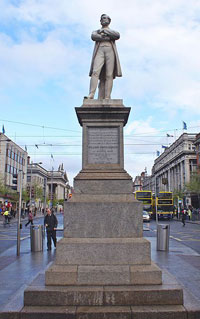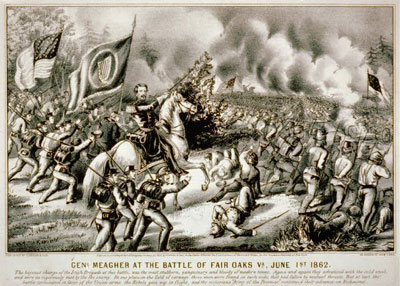Young Irelanders: Exiles in Paradise
Life after Van Diemen's Land
 The fates of the Young Irelanders after leaving Van Diemen's Land were as varied as their individual personalities, characters and personal histories. On 26 July O'Brien and Martin left Australia on board the Norma bound for Ceylon, where they parted company. O'Brien continued on to Malta via Madras, where he visited his brother-in-law. He then travelled to Europe, settled for a period in Brussels and completed his book Principles of Government. In 1856 a free pardon was announced for the exiles and on 8 July, after further travelling in Europe, O'Brien returned to Ireland where he continued to uphold the ideals of Young Ireland.
The fates of the Young Irelanders after leaving Van Diemen's Land were as varied as their individual personalities, characters and personal histories. On 26 July O'Brien and Martin left Australia on board the Norma bound for Ceylon, where they parted company. O'Brien continued on to Malta via Madras, where he visited his brother-in-law. He then travelled to Europe, settled for a period in Brussels and completed his book Principles of Government. In 1856 a free pardon was announced for the exiles and on 8 July, after further travelling in Europe, O'Brien returned to Ireland where he continued to uphold the ideals of Young Ireland.
Although once again invited to enter politics, O'Brien preferred to pursue public involvement through scholarship. He was a member of several learned societies, often dealing with Irish language and culture. He also set out to make himself proficient in Gaelic. He was active as a publicist on political matters with addresses to the Irish nation, though he did not attend public demonstrations. He travelled widely including the United States and Canada in 1859 where he reunited with Mitchel and Meagher and was generally feted as a major public figure. He returned to Ireland, but after his wife Lucy died in 1861 continued his travels on the Continent. O'Brien died in Bangor, Wales, on 18 June 1864 and was given a large public funeral. In 1870 John Martin unveiled a statue of O'Brien, which still stands in O'Connell Street, Dublin.
After leaving O'Brien in Ceylon, Martin continued on to Paris where he settled for several years. In 1858 he returned to Ireland and once more became involved in politics helping to establish the 'National League', which sought to obtain the legislative independence of Ireland. In May 1870 he joined the 'Home Government Association of Ireland' and the following year returned to Parliament as a Home Ruler, continuing to advocate for the political freedom of the Irish people. He died on 29 March 1875, aged 63, from an attack of bronchitis evidently contracted after attending John Mitchel's funeral two weeks previously.
Kevin O'Doherty, being the young man that he was, decided to stay longer in Melbourne and try his luck at gold prospecting in the Victorian goldfields. He travelled to Paris where he continued to study medicine and married Irish nationalist poet Mary Eva Kelly. After his full pardon O'Doherty returned to Ireland completing his medical studies in Dublin in 1857. He returned to Australia in 1886, intending to resume his practice of medicine. He also sat in the Queensland legislature and, on returning for a time to Ireland, in the House of Commons as a Home Ruler. He died in Brisbane on 15 July 1905.
P.J. Smyth married Jeannie Regan in Hobart, Tasmania, and returned to Ireland with her. Back in Ireland, Smyth remained active in politics: he was elected as MP for Westmeath and Tipperary and continued to promote the Irish cause.
In America, MacManus, Meagher and Mitchel pursued their lives with varying success. MacManus endeavoured to return to the world of commerce resuming his former business of a shipping agent. His efforts met with little success and he died in America in 1860 impoverished and disillusioned.
 After escaping to America Meagher employed his talents as an orator and became a success on the public lecture circuit. In 1855 he was admitted to the New York bar and practised as a lawyer. At the outbreak of civil war he served with the army during the first campaign in Virginia. Towards the end of 1861 he organised the 'Irish Brigade' and was elected colonel of the first regiment from which he rose to the rank of Brigadier General. In 1865 at the conclusion of the war Meagher was nominated secretary of Montana territory and in September 1866 became temporary governor. The following year, on 1 July 1867, he drowned in mysterious and inconclusive circumstances on the Missouri River near Fort Benton, Montana, aged forty-three. His body was never recovered, and some believed he was assassinated and buried in an unmarked grave.
After escaping to America Meagher employed his talents as an orator and became a success on the public lecture circuit. In 1855 he was admitted to the New York bar and practised as a lawyer. At the outbreak of civil war he served with the army during the first campaign in Virginia. Towards the end of 1861 he organised the 'Irish Brigade' and was elected colonel of the first regiment from which he rose to the rank of Brigadier General. In 1865 at the conclusion of the war Meagher was nominated secretary of Montana territory and in September 1866 became temporary governor. The following year, on 1 July 1867, he drowned in mysterious and inconclusive circumstances on the Missouri River near Fort Benton, Montana, aged forty-three. His body was never recovered, and some believed he was assassinated and buried in an unmarked grave.
Of all the Young Irelanders’ careers after leaving Van Diemen's Land, Mitchel's was arguably the most famous, or, in the view of some, infamous. He was certainly the most widely read and highly regarded in the nationalist community. After his escape and arrival in New York he founded a newspaper called The Citizen, in which he serialised his experiences as a convicted felon since leaving Ireland. He opposed the abolition movement and from October 1857 to August 1859 published a weekly journal called the Southern Citizen in the interests of the slaveholders. At the conclusion of the Civil War he returned to New York where he became editor of the Daily News and was arrested for articles supporting slavery, subsequently spending five months in prison. On release he became involved with the Fenian movement and in October 1867 established a newspaper called the Irish Citizen, which was published until July 1872. Nominated in 1874—while in America—to represent Tipperary Mitchel was unsuccessful yet was then controversially elected unopposed in February 1875. True to style Mitchel announced his intention of 'discrediting and exploding the fraudulent pretence of Irish representation by declining to attend the sittings of Parliament'.1 His political career was cut short by his untimely death at Dromalane on 20 March 1875, at age fifty-nine.
